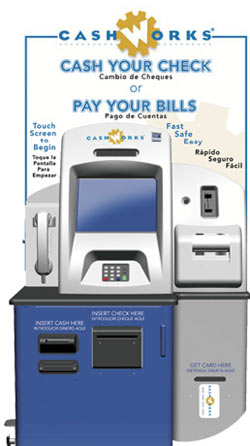Article
Checks and balances
While direct deposit and online banks have changed the way many people handle their money, there are still countless paychecks generated and distributed every Friday. Emerging kiosk designs aim to help workers convert those checks into currency of one sort or another.
June 27, 2005 by James Bickers — Editor, Networld Alliance
No matter how much we love our jobs, most of us will offer the same answer when asked what we like best about them: getting paid.
Direct deposit has simplified life for HR departments and employees alike, but there are still millions of paychecks placed into eager hands every week. While many of those checks will be deposited in a bank account, a significant number will be cashed at a bank, c-store or check-cashing outlet.
The rise in prominence of the CCO points to the increasing number of workers who, for one reason or another, do not deal with a traditional bank. According to United Financial Services Group, which operates 133 CCOs in 17 states, 13,000 CCOs are open for business across the country, cashing a whopping $80 billion worth of checks every year.
 This story and all the great free content on KioskMarketplace is supported by: Looks Cool, Runs Cooler  |
Several kiosk companies have been working hard on an automated, self-service offering for this market, among them Tranax Technologies, which announced its Check Cashing Self-Service Terminal in May. Developed in conjunction with Amarillo, Texas-based Financial Payments LP, the device combines check-cashing and debit-card issuance with a traditional ATM.
"The need for check-cashing terminals grows as convenience for the service is demanded," said Scott Holt, product manager for self-service terminals with Tranax. He points to the growing availability of check-cashing services in places like grocery chains, liquor stores and virtually any high-volume retail location.
Tranax's check-cashing kiosk accepts a check and scans both sides. Those two images, along with the accompanying transaction data, are sent to Financial Payments' TrueCheck processing system, which handles the risk analysis and processing. Approval or denial is sent back to the machine, and the customer is told that his funds have been added to a stored-value card. The customer then has the option of receiving cash back, and the card is dispensed.
Another high-profile entry came in 2004 when GE Consumer Finance acquired CashWorks, a Dallas-based company. Like the Tranax model, the CashWorks kiosk utilizes a proprietary decision-making database.
"Because CashWorks is backed by the financial power of GE Consumer Finance, the operator assumes none of the financial burden of approving the check," said Will Sowell, general manager of CashWorks. "Once approved, the customer receives a prepaid card which he can then use to withdraw cash from the in-store ATM at no extra fee, or take with to use as a traditional debit card." While at the kiosk, the customer also can use his funds to pay bills electronically.

High-end tech
The technology behind check-cashing kiosks is on the cutting edge of the industry. Document acceptors have long been the bane of manufacturer and customer alike, and check acceptors face all the usual challenges - reading a check that has been folded three times and sat in a worker's back pocket for an hour, for instance.
But once the check is accepted and scanned, bigger challenges lay ahead.
"More complex than the hardware technology that scans the check is the degree and level to which the software can analyze that check for payment to provide a positive customer experience," said Dave Grano, chief executive officer of VERO, an Oregon-based firm whose check-cashing kiosk also offers wire transfers, bill payment and money orders. "Traditional check-cashing utilizes the check MICR data primarily, if not exclusively, to analyze the check, resulting in 70 to 75 percent accuracy Â… which is too low for a viable customer product."
Grano said that in addition to MICR data, VERO's software uses a large number of inspection points throughout the check.
Holt also placed emphasis on the strength of the software behind the scenes. "Substantial R&D went into the development of the current check-scanning module, which focused heavily in reading checks of different conditions and formats," he said.
|
Not just for the unbanked
Conventional wisdom seems to suggest that the primary market for check-cashing kiosks is the "unbanked" - that portion of the population that, for one reason or another, has no relationship with a bank. According to a 2000 survey, there are more than 20 million unbanked families in the U.S.
And that group of people is spending a lot of money, according to Sowell. "The underserved population Â… spends an estimated $10 billion annually on transactions such as check cashing, money orders, money transfers, prepaid cards and bill payments," he said.
While the unbanked population might represent the biggest potential market for check-cashing kiosks, it is certainly not the only one. An analogy can be found in the early days of off-site ATMs, when it was assumed that people would never willingly pay a fee for ATM use when their bank's machine didn't charge one. That turned out to be very wrong, as people found the convenience of the machines to be well worth the fee.
"Check-cashing services report that more than 45 percent of customers using their service have banking relationships, but choose to use the service because of convenience," Holt said.
It's easy to speculate that the same dynamic might hold true for the kiosk.
"CashWorks has already noticed a significant proportion of its customers, approximately two-thirds, do have some form of bank account and choose to use CashWorks to provide their check-cashing services," said Sowell. "Often it has to do with issues of convenience, such as a work schedule that makes it difficult to conduct banking during normal hours."












